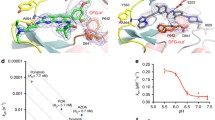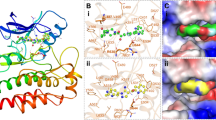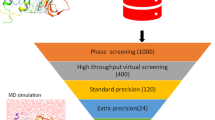Abstract
Tyrosine kinases are a wide family of targets with strong pharmacological relevance. These proteins undergo large-scale conformational motions able to inactivate them. By the end of one of these structural processes, a new cavity is opened allowing the access to a specific type of inhibitors, called type II. The kinase domain of fibroblast growth factor receptor 3 (FGFR3) falls into this family of kinases. We describe here, for the first time, its inactivation process through target molecular dynamics. The transient cavity, at the crossroad between the DFGout and Cα helix out inactivation is herein explored. Molecular docking calculations of known ligands demonstrated that type II inhibitors are able to interact with this metastable transient conformation of FGFR3 kinase. Besides, supplemental computations were conducted and clearly show that type II inhibitors drive the kinase inactivation process through specific stabilization with the DFG triad. This induced-fit effect of type II ligands toward FGFR3 might be extrapolated to other kinase systems and provides meaningful structural information for future drug developments.











Similar content being viewed by others

References
Mannig G, Whyte DB, Martinez R, Hunter T, Sudarsanam S (2002) The protein kinase complement of the human genome. Science 298:1912–1934
Hanks SK (2003) Genomic analysis of the eukaryotic protein kinase superfamily: a perspective. Genome Biol 4:111
Cohen P (2002) Protein kinases—the major drug targets of the twenty-first century? Nat Rev Drug Discov 1:309–315
Zuccotto F, Ardini E, Casale E, Angiolini M (2010) Through the “gatekeeper door”: exploiting the active kinase conformation. J Med Chem 53:2681–2694
Shan Y, Seeliger MA, Eastwood MP, Frank F, Xu H, Jensen MØ, Dror RO, Kuriyan J, Shaw DE (2009) A conserved protonation-dependent switch controls drug binding in the Abl kinase. Proc Natl Acad Sci USA 106:139–144
Johnson LN, Lowe ED, Noble ME, Owen D (1998) The eleventh Datta lecture. The structural basis for substrate recognition and control by protein kinases. FEBS Lett 430:1–11
Huse M, Kuriyan J (2002) The conformational plasticity of protein kinases. Cell 209:275–282
Lin Y-L, Roux B (2013) Computational analysis of the binding specificity of Gleevec to Abl, c-Kit, Lck, and c-Src tyrosine kinases. J Am Chem Soc 135:14741–14753
Lin Y-L, Meng Y, Jiang W, Roux B (2013) Explaining why Gleevec is a specific and potent inhibitor of Abl kinase. Proc Natl Acad Sci USA 110:1664–1669
Lin Y-L, Meng Y, Huang L, Roux B (2014) Computational study of Gleevec and G6G reveals molecular determinants of kinase inhibitor selectivity. J Am Chem Soc 136:14753–14762
Shukla D, Meng Y, Roux B, Pande VS (2014) Activation pathway of Src kinase reveals intermediate states as targets for drug design. Nat Commun 5:3397
Levinson NM, Kuchment O, Shen K, Young Ma, Koldobskiy M, Karplus M, Cole Pa, Kuriyan J (2006) A Src-like inactive conformation in the abl tyrosine kinase domain. PLoS Biol 4:e144
Rousseau F, El Ghouzzi V, Delezoide AL, Legeai-Mallet L, Le Merrer M, Munnich A, Bonaventure J (1996) Missense FGFR3 mutations create cysteine residues in thanatophoric dwarfism type I (TDI). Hum Mol Genet 5:509–512
Rousseau F, Bonaventure J, Legeai-Mallet L, Pelet A, Rozet JM, Maroteaux P, Le Merrer M, Munnich A (1994) Mutations in the gene encoding fibroblast growth factor receptor-3 in achondroplasia. Nature 371:252–254
Le Merrer M, Rousseau F, Legeai-Mallet L, Landais JC, Pelet A, Rozet JM, Bonaventure J, Sanak M, Weissenbach J, Stoll C, Munnich A, Maroteaux P (1994) A gene for achondroplasia–hypochondroplasia maps to chromosome 4p. Nat Genet 6:318–321
Tanaka N, Katsuma N, Horikawa R, Tanaka T (2003) The comparison of the effects of short-term growth hormone treatment in patients with achondroplasia and with hypochondroplasia. Endocrinol J 50:69–75
Yasui N, Kawabata H, Kojimoto H, Ohno H, Matsuda S, Araki N, Shimomura Y, Ochi T (1997) Lengthening of the lower limbs in patients with achondroplasia and hypochondroplasia. Clin Orthop Relat Res 344:298–306
Tak-Tak L, Barbault F, Maurel F, Busca P, Le Merrer Y (2011) Synthesis of purin-2-yl and purin-6-yl-aminoglucitols as C-nucleosidic ATP mimics and biological evaluation as FGFR3 inhibitors. Eur J Med Chem 46:1254–1262
Jonquoy A, Mugniery E, Benoist-Lasselin C, Kaci N, Le Corre L, Barbault F, Girard A-L, Le Merrer Y, Busca P, Schibler L, Munnich A, Legeai-Mallet L (2012) A novel tyrosine kinase inhibitor restores chondrocyte differentiation and promotes bone growth in a gain-of-function FGFR3 mouse model. Hum Mol Genet 21:841–851
Han S, Mistry A, Chang JS, Cunningham D, Criffor M, Bonnette PC, Wang H, Chrunyk BA, Aspnes GE, Walker DP, Brosius AD, Buckbinder L (2009) Structural characterization of proline-rich tyrosine kinase 2 (PYK2) reveals a unique DFG-out conformation and enables inhibitor design. J Biol Chem 8:13193–13201
Vogtherr M, Saxena K, Hoelder S, Grimme S, Betz M, Schieborn U, Pescatore B, Robin M, Delarbe L, Langer T, Wendt KU, Schwalbe H (2006) NMR characterization of kinase p38 dynamics in free and ligand bound form. Angew Chem Int Ed 45:993–997
Schrödinger: Maestro suite 2011. LLC New York, NY (2011)
Wang J, Wolf R, Caldwell J, Kollman P, Case D (2004) Development and testing of a general amber force field. J Comput Chem 25:1157–1174
Case D, Darden T, Cheatham T, Simmerling C, Wang J, Duke L, Luo R, Crowley M, Walker R, Zhang W, Merz K, Wang B, Hayik S, Roitberg A, Seabra G, Kolossvary I, Wong K, Paesani F, Vanicek J, Wu X, Brozell S, Steinbrecher T, Gohlke H, Yang L, Tan C, Mongan J, Hornak V, Gui G, Mathews D, Seetin M, et al (2010) AMBER v11. 2010
Bocharov EV, Lesovoy DM, Goncharuk SA, Goncharuk MV, Hristova K, Arseniev AS (2013) Structure of FGFR3 transmembrane domain dimer: implications for signaling and human pathologies. Structure 21:2087–2093
Mohammadi M, Froum S, Hamby JM, Schroeder MC, Panek RL, Lu GH, Eliseenkova AV, Green D, Schlessinger J, Hubbard SR (1998) Crystal structure of an angiogenesis inhibitor bound to the FGF receptor tyrosine kinase domain. EMBO J 17:5896–5904
Bae JH, Boggon TJ, Tomé F, Mandiyan V, Lax I, Schlessinger J (2010) Asymmetric receptor contact is required for tyrosine autophosphorylation of fibroblast growth factor receptor in living cells. Proc Natl Acad Sci USA 107:2866–2871
Mohammadi M (1996) Structure of the FGF receptor tyrosine kinase domain reveals a novel autoinhibitory mechanism. Cell 86:577–587
Ravindranathan KP, Mandiyan V, Ekkati AR, Bae JH, Schlessinger J, Jorgensen WL (2010) Discovery of novel fibroblast growth factor receptor 1 kinase inhibitors by structure-based virtual screening. J Med Chem 53:1662–1672
Eathiraj S, Palma R, Hirschi M, Volckova E, Nakuci E, Castro J, Chen C-R, Chan TCK, France DS, Ashwell MA (2011) A novel mode of protein kinase inhibition exploiting hydrophobic motifs of autoinhibited kinases: discovery of ATP-independent inhibitors of fibroblast growth factor receptor. J Biol Chem 286:20677–20687
Ibrahimi OA, Eliseenkova AV, Plotnikov AN, Yu K, Ornitz DM, Mohammadi M (2001) Structural basis for fibroblast growth factor receptor 2 activation in Apert syndrome. Proc Natl Acad Sci USA 98:7182–7187
Chen H, Ma J, Li W, Eliseenkova AV, Xu C, Neubert TA, Miller WT, Mohammadi M (2007) A molecular brake in the kinase hinge region regulates the activity of receptor tyrosine kinases. Mol Cell 27:717–730
Lambert C, Leonard N, De Bolle X, Depiereux E (2002) ESyPred3D: prediction of proteins 3D structures. Bioinformatics 18:1250–1256
Darden T, York D, Pedersen L (1993) Particle mesh Ewald: An N log(N) method for Ewald sums in large systems. J Chem Phys 98:10089–10092
Lindorff-Larsen K, Piana S, Palmo K, Maragakis P, Klepeis J, Dror RO, Shaw DE (2010) Improved side-chain torsion potentials for the Amber ff99SB protein force field. Proteins 78:1950–1958
Jakalian A, Bush B, Jack D, Bayly C (2000) Fast, efficient generation of high-quality atomic charges. AM1-BCC model: I. Method. J Comput Chem 21:132–146
Jakalian A, Jack D, Bayly C (2002) Fast, efficient generation of high-quality atomic charges. AM1-BCC model: II. Parameterization and validation. J Comput Chem 23:1623–1641
Ryckaert J, Ciccotti G, Berendsen H (1977) Numerical integration of the cartesian equations of motion of a system with constraints: molecular dynamics of N-alkanes. J Comput Phys 23:327–341
Uberuaga BP, Anghel M, Voter AF (2004) Synchronization of trajectories in canonical molecular-dynamics simulations: observation, explanation, and exploitation. J Chem Phys 120:6363–6374
Pastor RW, Brooks BR, Szabo A (1988) An analysis of the accuracy of Langevin and molecular dynamics algorithms. Mol Phys 65:1409–1419
Schlitter I, Engels M, Krüger P (1994) Targeted molecular dynamics: a new approach for searching pathways of conformational transition. J Mol Graph 12:84–89
Karplus M, Kuriyan J (2005) Molecular dynamics and protein function. Proc Natl Acad Sci USA 102:6679–6685
Li Y, Barbault F, Delamar M (2013) Targeted molecular dynamics (TMD) of the full-length KcsA potassium channel: on the role of the cytoplasmic domain in the opening process. J Mol Model 19:1651–1666
Papaelo E, Mereghetti P, Fantucci P, Grandori R, De Goia L (2009) Free-energy landscape, principal component analysis, and structural clustering to identify representative conformations from molecular dynamics simulations: the myoglobin case. J Mol Graph Model 27:889–899
Morris G, Huey R, Lindstrom W, Sanner M, Belew R, Goodsell D, Olson A (2009) AutoDock4 and AutoDock Tools4: automated docking with selective receptor flexibility. J Comput Chem 30:2785–2791
Teixeira C, Serradji N, Maurel F, Barbault F (2009) Docking and 3D-QSAR studies of BMS-806 analogs as HIV-1 gp120 entry inhibitors. Eur J Med Chem 44:3524–3532
Teixeira C, Barbault F, Rebehmed J, Liu K, Xie L, Lu H, Jiang S, Fan B, Maurel F (2008) Molecular modeling studies of N-substituted pyrrole derivatives–potential HIV-1 gp41 inhibitors. Bioorg Med Chem 16:3039–3048
Koes D, Camacho C (2011) Pharmer: efficient and exact pharmacophore search. J Chem Inf Model 51:1307–1314
Kollman P, Massova I, Reyes C, Kuhn B, Huo S, Chong L, Lee M, Lee T, Duan Y, Wang W, Donini O, Cieplak P, Srinivasan J, Case D, Cheatham T (2000) Calculating structures and free energies of complex molecules: combining molecular mechanics and continuum models. Acc Chem Res 33:889–897
Aixiao L, Barbault F, Maurel F, Delamar M, Wang B (2008) Interaction mode and selectivity of the 2PU inhibitor with the CDK4 and CDK2 cyclin-dependant kinases: a molecular dynamics study. J Mol Struct (Thoechem) 849:62–75
Barbault F, Maurel F (2012) Is inhibition process better described with MD(QM/MM) simulations? The case of urokinase type plasminogen activator inhibitors. J Comput Chem 33:607–616
Aixiao L, Maurel F, Barbault F, Delamar M, Wang B, Zhou X, Wang P (2010) Molecular modeling study of binding site selectivity of TQMP to G-quadruplex DNA. Eur J Med Chem 45:983–991
Barbault F, Ren B, Rebehmed J, Teixeira C, Luo Y, Smila-Castro O, Maurel F, Fan B, Zhang L, Zhang L (2008) Flexible computational docking studies of new aminoglycosides targeting RNA 16S bacterial ribosome site. Eur J Med Chem 43:1648–1656
Gourmala C, Luo Y, Barbault F, Zhang Y, Ghalem S, Maurel F, Fan B (2007) Elucidation of the LewisX–LewisX carbohydrate interaction with molecular dynamics simulations: a glycosynapse model. J Mol Struct (Thoechem) 821:22–29
Luo Y, Barbault F, Gourmala C, Zhang Y, Maurel F, Hu Y, Fan BT (2008) Cellular interaction through LewisX cluster: theoretical studies. J Mol Model 14:901–910
Sitkoff D, Sharp K, Honig B (1994) Correlating solvation free energies and surface tensions of hydrocarbon solutes. Biophys Chem 51:397–403
Sitkoff D, Lockhart D, Sharp K, Honig B (1994) Calculation of electrostatic effects at the amino terminus of an alpha helix. Biophys J 67:2251–2260
Luo R, David L, Gilson M (2002) Accelarated Poisson Boltzmann calculations for static and dynamic systems. J Comput Chem 23:1244–1253
Kottalam J, Case D (1990) Langevin modes of macromolecules: application to crambin and DNA hexamers. Biopolymers 29:1409–1421
Teixeira C, Serradji N, Amroune S, Storck K (2013) Is the conformational flexibility of piperazine derivatives important to inhibit HIV-1 replication? J Mol Graph Model 44:91–103
Berteotti A, Cavalli A, Branduardi D, Gervasio FL, Recanatini M, Parrinello M (2009) Protein conformational transitions: the closure mechanism of a kinase explored by atomistic simulations. J Am Chem Soc 131:244–250
Gan W, Yang S, Roux B (2009) Atomistic view of the conformational activation of Src kinase using the string method with swarms-of-trajectories. Biophys J 97:L8–L10
Filomia F, De Rienzo F, Menziani MC (2010) Insights into MAPK p38alpha DFG flip mechanism by accelerated molecular dynamics. Bioorg Med Chem 18:6805–6812
Laine E, Chauvot de Beauchêne I, Perahia D, Auclair C, Tchertanov L (2011) Mutation D816V alters the internal structure and dynamics of c-KIT receptor cytoplasmic region: implications for dimerization and activation mechanisms. PLoS Comput Biol 7:e1002068
Jacobs MD, Caron PR, Hare BJ (2008) Classifying protein kinase structures guides use of ligand-selectivity profiles to predict inactive conformations: structure of lck/imatinib complex. Proteins 70:1451–1460
Kufareva I, Abagyan R (2008) Type-II kinase inhibitor docking, screening, and profiling using modified structures of active kinase states. J Med Chem 51:7921–7932
Ribeiro JV, Tamames JAC, Cerqueira NMFSA, Fernandes PA, Ramos MJ (2013) Volarea—a bioinformatics tool to calculate the surface area and the volume of molecular systems. Chem Biol Drug Des 82:743–755
Reaction biology corp. http://www.reactionbiology.com
Lamers MB, Antson AA, Hubbard RE, Scott RK, Williams DH (1999) Structure of the protein tyrosine kinase domain of C-terminal Src kinase (CSK) in complex with staurosporine. J Mol Biol 285:713–725
Le Corre L, Girard A-L, Aubertin J, Radvanyi F, Benoist-Lasselin C, Jonquoy A, Mugniery E, Legeai-Mallet L, Busca P, Le Merrer Y (2010) Synthesis and biological evaluation of a triazole-based library of pyrido[2,3-d]pyrimidines as FGFR3 tyrosine kinase inhibitors. Org Biomol Chem 8:2164–2173
Thomas M, Huang W-S, Wen D, Zhu X, Wang Y, Metcalf CA, Liu S, Chen I, Romero J, Zou D, Sundaramoorthi R, Li F, Qi J, Cai L, Zhou T, Commodore L, Xu Q, Keats J, Wang F, Wardwell S, Ning Y, Snodgrass JT, Broudy MI, Russian K, Iuliucci J, Rivera VM, Sawyer TK, Dalgarno DC, Clackson T, Shakespeare WC (2011) Discovery of 5-(arenethynyl) hetero-monocyclic derivatives as potent inhibitors of BCR-ABL including the T315I gatekeeper mutant. Bioorg Med Chem Lett 21:3743–3748
Choi HG, Ren P, Adrian F, Sun F, Lee HS, Wang X, Ding Q, Zhang G, Xie Y, Zhang J, Liu Y, Tuntland T, Warmuth M, Manley PW, Mestan J, Gray NS, Sim T (2010) A type-II kinase inhibitor capable of inhibiting the T315I “gatekeeper” mutant of Bcr-Abl. J Med Chem 53:5439–5448
ChemAxon. http://www.chemaxon.com/product/pka.html
Hu R, Barbault F, Maurel F, Delamar M, Zhang R (2010) Molecular dynamics simulations of 2-amino-6-arylsulphonylbenzonitriles analogues as HIV inhibitors: interaction modes and binding free energies. Chem Biol Drug Des 76:518–526
Klepeis JL, Lindorff-Larsen K, Dror RO, Shaw DE (2009) Long-timescale molecular dynamics simulations of protein structure and function. Curr Opin Struct Biol 19:120–127
Müller K, Faeh C, Diederich F (2007) Fluorine in pharmaceuticals: looking beyond intuition. Science 317:1881–1886
Paulini R, Müller K, Diederich F (2005) Orthogonal multipolar interactions in structural chemistry and biology. Angew Chem Int Ed 44:1788–1805
Grant BJ, Gorfe AA, McCammon JA (2010) Large conformational changes in proteins: signaling and other functions. Curr Opin Struct Biol 20:142–147
Fabian M, Biggs W 3rd, Treiber D, Atteridge C, Azimioara M, Benedetti M, Carter T, Ciceri P, Edeen P, Floyd M, Ford J, Galvin M, Gerlach J, Grotzfeld R, Herrgard S, Insko D, Insko M, Lai A, Lélias J, Mehta S, Milanov Z, Velasco A, Wodicka L, Patel H, Zarrinkar P, Lockhart D (2005) A small molecule-kinase interaction map for clinical kinase inhibitors. Nat Biotechnol 23:329–336
Agafonov RV, Wilson C, Otten R, Buosi V, Kern D (2014) Energetic dissection of Gleevec’s selectivity toward human tyrosine kinases. Nat Struct Mol Biol 21:848–853
Acknowledgments
The China Scholarship Council is gratefully acknowledged for granting a Ph.D. scholarship to Yan LI. This work was granted access to the CINES (Centre Informatique National de l’Enseignement Supérieur, France) under the allocation c2013077022 made by GENCI (Grand Equipement National de Calcul Intensif). Financial support from the French agency ANR (Agence Nationale de la Recherche), under the program Grant name “ATAK”, is gratefully acknowledged.
Author information
Authors and Affiliations
Corresponding author
Electronic supplementary material
Below is the link to the electronic supplementary material.
Rights and permissions
About this article
Cite this article
Li, Y., Delamar, M., Busca, P. et al. Molecular modeling study of the induced-fit effect on kinase inhibition: the case of fibroblast growth factor receptor 3 (FGFR3). J Comput Aided Mol Des 29, 619–641 (2015). https://doi.org/10.1007/s10822-015-9841-8
Received:
Accepted:
Published:
Issue Date:
DOI: https://doi.org/10.1007/s10822-015-9841-8



